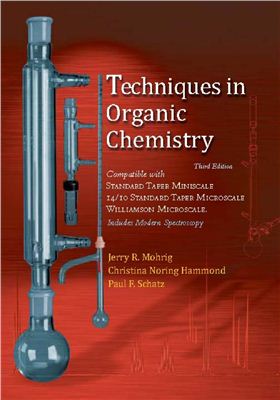3rd ed. W.H.Freeman and Company. 2010. 487 p.
Techniques in Organic Chemistry is the most comprehensive presentation of lab techniques available for organic chemistry students—and the least expensive. This book is intended to serve as a laboratory textbook of experimental techniques for all students of organic chemistry. It is written to provide effective support for guided-inquiry and design-based experiments and projects, as well as for traditional lab experiments. Techniques in Organic Chemistry combines specific instructions for 3 different kinds of laboratory glassware (miniscale, standard-taper microscale, Williamson microscale). It offers extensive coverage of spectroscopic techniques and a strong emphasis on safety issues. It can be used in conjunction with any lab experiments to provide the background and skills necessary for mastering the organic chemistry laboratory.
The techniques manual may be purchased separately, or it can be packaged with either version of Mohrig’s Mode Projects and Experiments in Organic Chemistry or with an instructor’s own experiments through Freeman Custom Publishing.
Contents
Introduction to the Organic Laboratory
Safety in the Laboratory
Protecting the Environment
Laboratory Notebooks and Prelaboratory Information
Carrying out Chemical Reactions
Laboratory Glassware
Measurements and Transferring Reagents
Heating and Cooling Methods
Assembling a Reaction Apparatus
Computational Chemistry
Designing a Chemical Reaction
Separation and Purification Techniques
Filtration
Extraction
Drying Organic Liquids and Recovering Reaction Products
Boiling Points and Distillation
Melting Points and Melting Ranges
Recrystallization
Specialized Techniques
Chromatography
Thin-Layer Chromatography
Liquid Chromatography
Gas Chromatography
Spectroscopic Methods
Infrared Spectroscopy
Nuclear Magnetic Resonance Spectroscopy
13C and Two-Dimensional NMR Spectroscopy
Mass Spectrometry
Ultraviolet and Visible Spectroscopy
Integrated Spectroscopy Problems
Techniques in Organic Chemistry is the most comprehensive presentation of lab techniques available for organic chemistry students—and the least expensive. This book is intended to serve as a laboratory textbook of experimental techniques for all students of organic chemistry. It is written to provide effective support for guided-inquiry and design-based experiments and projects, as well as for traditional lab experiments. Techniques in Organic Chemistry combines specific instructions for 3 different kinds of laboratory glassware (miniscale, standard-taper microscale, Williamson microscale). It offers extensive coverage of spectroscopic techniques and a strong emphasis on safety issues. It can be used in conjunction with any lab experiments to provide the background and skills necessary for mastering the organic chemistry laboratory.
The techniques manual may be purchased separately, or it can be packaged with either version of Mohrig’s Mode Projects and Experiments in Organic Chemistry or with an instructor’s own experiments through Freeman Custom Publishing.
Contents
Introduction to the Organic Laboratory
Safety in the Laboratory
Protecting the Environment
Laboratory Notebooks and Prelaboratory Information
Carrying out Chemical Reactions
Laboratory Glassware
Measurements and Transferring Reagents
Heating and Cooling Methods
Assembling a Reaction Apparatus
Computational Chemistry
Designing a Chemical Reaction
Separation and Purification Techniques
Filtration
Extraction
Drying Organic Liquids and Recovering Reaction Products
Boiling Points and Distillation
Melting Points and Melting Ranges
Recrystallization
Specialized Techniques
Chromatography
Thin-Layer Chromatography
Liquid Chromatography
Gas Chromatography
Spectroscopic Methods
Infrared Spectroscopy
Nuclear Magnetic Resonance Spectroscopy
13C and Two-Dimensional NMR Spectroscopy
Mass Spectrometry
Ultraviolet and Visible Spectroscopy
Integrated Spectroscopy Problems

